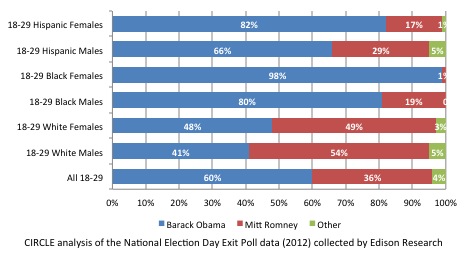Support for President Obama Varied Greatly by Gender and Race
Although young people favored President Obama, their level of support for him varied greatly by gender and race, ranging from 98% among Black women to 41% among White men. This CIRCLE fact sheet (PDF) takes a deeper look at how young men and women voters of different racial backgrounds voted, why they chose to vote the way they did, and how they differed from other groups.
This fact sheet is the second in a series CIRCLE is doing on the youth who voted in 2012. The first, an overview of young voters compared to older voters, can be found here.
Some findings from this analysis include:
★ Young White women’s influence in the youth electorate has decreased since 2008, while Hispanic influence has increased: 42% of young voters were persons of color, and for the first time, the Hispanic youth vote share surpassed the Black youth vote share. In 2008, the Hispanic youth vote represented 14% of the youth electorate. This year, it increased to 18%. Asian-American voters represented five percent of the youth vote in 2012.
★ Young Black and Hispanic women provided the strongest support for President Obama. A majority admired him, much as they did in 2008.
★ Young White men, as a group, held a quite different view of the President, the role of the government, and how to move forward with immigration reform than all the other groups. They were unhappy with the economy and wanted Governor Romney to improve the economy.
★ Young Hispanic men cast 9% of youth votes, up from 6% in 2008. Among the minority groups, they were most likely to affiliate with the Republican party or consider themselves independents, but two-thirds of them voted for President Obama.
★ Although a majority of young Black male voters supported President Obama again, a larger portion of them voted for the Republican candidate this year than the same group did in 2008. Young Black men voters were somewhat more conservative, younger and more likely to identify as Republicans or Independents in 2012 than in 2008. They were less likely to vote for Obama than young Black women this year, but Black men voters were already less excited about Obama than Black women voters back in 2008, implying a lasting gender gap in enthusiasm among young Black voters.
Download the fact sheet here (PDF). Look for more analysis from CIRCLE this week.







November 14th, 2012 at 5:37 pm
[…] “Diverse Electorate: A Deeper Look into the Millennial Vote,” by The Center for Information and Research on Civic Learning and Engagement looked at the nation’s 23 million young voters and found that, in some areas, they mirrored closely what was found among adult voters. […]
November 14th, 2012 at 9:47 pm
[…] “Diverse Electorate: A Deeper Look into the Millennial Vote” […]
November 15th, 2012 at 11:33 am
[…] Here are some takeaways, courtesy of CIRCLE. […]
November 19th, 2012 at 4:58 pm
[…] is coming out in the form of post-election reports and memos) with regard to money in politics, youth engagement, voting rights, and so on. It’s great research and worth checking out (we’ll be […]
December 31st, 2012 at 4:30 pm
[…] 2012 was the year in which sexual assault, and particularly its gendered dimensions, became something everyone had to acknowledge. And I mean everyone. There’s a lot of different issues that could be said to have defined the Republican Party during the US’s elections this year. From the racism to the classism, a constant refrain was that those with little deserved even less. Beyond those steps taken by the party, women, particularly if affected by sexual assault or other violence related to their gender, were subject to similarly stupid policies. Jezebel’s Erin Gloria Ryan wrote excellently in August about the fatigue of beginning to lose track of how many horrifying statements about rape and sexual violence had floated around the Republican Party, at times translating into actually disgusting policy proposals. The dangers were quite clear: electoral victories by the GOP would legitimize policies that reflected these admitted beliefs. Women voters (especially when young or of color) by and large got that message and sent their own response back. […]
January 24th, 2013 at 9:23 am
[…] Youth vote by gender and race […]
March 29th, 2014 at 4:10 pm
[…] part of his base. However his most recently policy chooses to focus on our brothers and our sons, but we street teamed for him in ways like no one else did. The data shows this. One of the central jobs […]